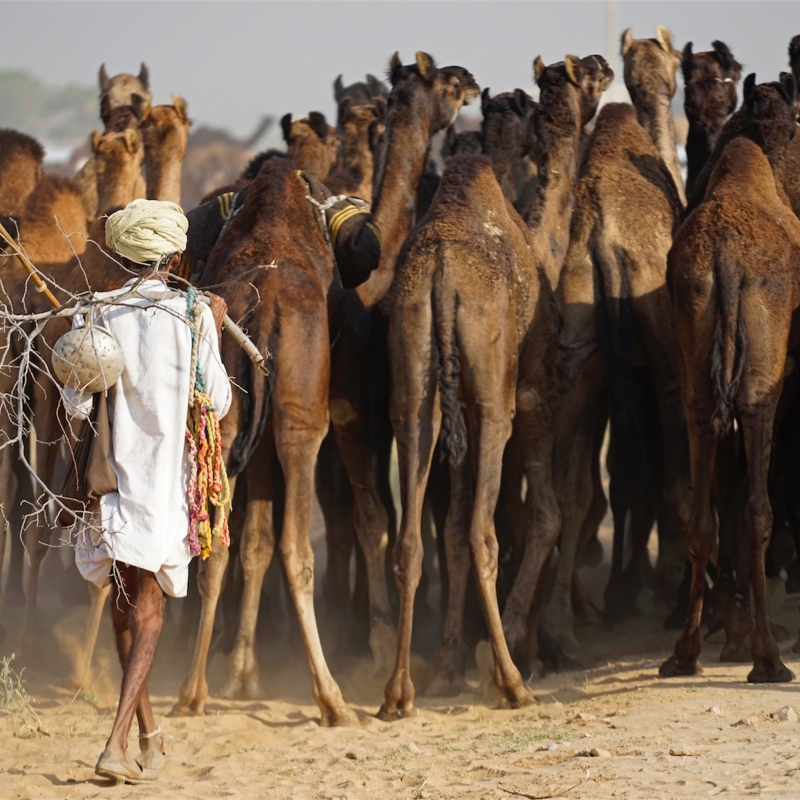Photo by DHEERAJ PAUL
PHOTOS BY DHEERAJ PAUL AND DINESH KHANNA
‘. . . O, sweet [bird] Kurjan
You are like my sister
Lower your wings
And come close to me
Allow me to write my grievances on your wings
And my greetings on your beak.
Hasten, sweet bird
Go to my dear one.’
(excerpt from the folk song Kurjan, as translated in Kothari 1972:55)
To the Sufi poet Khwaja Farid, the Cholistan desert—a part of the Thar/ Great Indian Desert—was no wasteland. He describes it as ‘a site of wildness and madness . . . the place of lovers . . . a place of joy and gladness’ (as quoted in Shackle 2007:94). For better or for worse, this desert landscape is the leitmotif in the rich traditions of folk tales and folk songs from the region.
Now divided between India and Pakistan, the Thar Desert was historically at the heart of the western frontier of South Asia. This western frontier region stretched from the doabs of Punjab, a patchwork of green and gold fields of wheat, maize, cane sugar and mustard intersected by rivers, to the crusty white salt marshlands of Kutch. It included the arid landscapes of Rajasthan and Sindh. From east to west, Rajasthan consists of rocky scrublands that briefly arch into the Aravalli hills and then dissolve into a golden sea of sand dunes that stretch into Sindh. The western frontier consisted of cultures at crossroads, rather than at the ‘mainstream’ of India, that developed along distinctive lines based on a strong tradition of vernacular languages and folk cultures. For the longest time, before the Partition of India and before colonial intervention, the ‘wanderings’ of agro-pastoralists, traders, musicians, bards, ascetics, soldiers and adventurers defined the region (Gommans 2002:43, 48).[1]
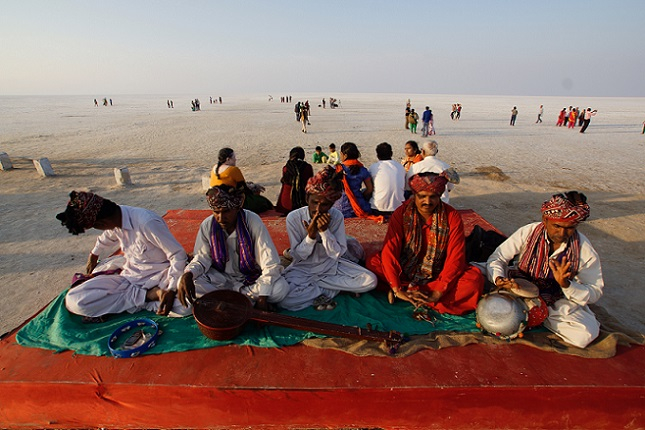
Fig. 1. Itinerant musicians perform in the open on the salt desert of Kutch. Photo by DHEERAJ PAUL.
Shared experiences are manifest in tales of romance, valour and faith. The culture of wandering is highlighted in the epic romance of Dhola-Maru, sung as a ballad by the Langa and Manganiar musicians. A prince of Narvar, Dhola, and a princess of Pugal in Marwar, Maruni, Marwan or Maru, are married as children, expected to be united as adults.[2] However, the marriage is all but forgotten until Maru grows up, dreams about Dhola and is gripped with desire for him. Dhola, in the meanwhile, may well have moved on with a second wife, Malvani, a princess of Malwa, who is determined to sabotage any attempts by Maru and her parents to send word to Dhola. ‘Desert wanderers’, a horse-trader, Dhadhi musicians, Charan bards and a yogi, serve as intermediaries and abettors until Dhola and Maru are finally reunited.
Musicians from Pugal reach Narvar and literally sing Maru’s praises besides Dhola’s palace. ‘Their tale made ardent desire spring up in Dhola’s heart’ (Vaudeville 1996:309). He becomes desperate to travel to Pugal to claim Maru but convincing Malvani to let him go on a journey is easier said than done. He first tries to cajole her to let him travel and try his fortune, promising to lavish her with gifts:
If you let me, I will go and serve the king of Idar [in Gujarat], there I will have jewels carved for you, and I will send them to you . . . I want to go to Multan, the bowmen there are highly paid: O gazelle-eyed lady, if you will consent with a smile, I will bring you back a herd of Tukhar [or Central Asian] horses! . . . The camels of Kacch [or Kutch], with two humps, cover [a long distance] in half an hour: O Fair One, listen, if you say yes with a smile, I will go and fetch you one (Vaudeville 1996:310–11).
But Malvani is unmoved and Dhola is forced to tell her truth, hardly designed to lower her resistance. Dhola is finally able to wear her down and flee to Pugal on a special camel. Malvani is left swooning and pining. In any case, she is not the last of the couple’s problems. After a delirious reunion in Pugal, on their journey back to Narvar, Maru is bitten by a snake but then revived by a yogi. They are then chased by a band of ‘desert prowlers’ or plundering horsemen after their chief, Umar Sumra, eyes Maru, until a bard convinces Umar Sumra to leave the couple alone. They finally make it to Narvar, where Maru is installed as Dhola’s favourite wife. An interesting afterword is the rivalry between the two wives that takes the form of the two disparaging each other’s homelands. Malvani heaps disdain on the barren landscape of Marwar. Indeed, in a precis version of the ballad sung by Langa musicians in western Rajasthan to date, Dhola himself asks Maru how a woman as beautiful as her can be born in Marwar, the land of thorny trees—khejdi, rohido and kumatiyo—and prickly grass. However, he defends Marwar to Malvani and, thus, Maru is a metaphor for the unlikely beauty of the desert.
Separation and longing are recurrent themes in romances from a region where lovers were often parted as the men had to travel. In Vijaydan Detha’s iconic retelling of a Rajasthan folk tale, Duvidha, the decision of the trader’s son to go on an extended business trip without a thought to his new bride forms the plot device. He leaves a vacuum that is filled by a ghost assuming his appearance, with the knowledge of the wife. In the epic romance of Jasma Odan, Jasma exchanges the life of a princess for a labourer’s when she chooses to marry into the Od community, rejecting all others. The Ods used to dig wells and tanks, and it was the one community where the men and the women worked alongside each other.
In this article, I explore the nomadic culture and shared history of this frontier region with reference to the Thar by taking a close look at representative communities of pastoralists, the Raikas, bards, the Charans, and musicians, the Langas and the Manganiars. Although the focus is on these particular communities, others are referenced throughout in text and photos.
***
Pastoralists from the Raika, Gujar, Jat, Sindhi Sipahi and Rajput communities lived rough lives herding their camels (in the case of the Raikas) and sheep through the Thar in search of seasonal pastures, travelling as far as Gujarat, Malwa in western-central India, Sindh and Punjab. In Vijaydan Detha’s Duvidha, the eponymous ‘dilemma’ is resolved by a wise shepherd where an entire village fails, his earthy wisdom surely honed by living by his wits close to nature.
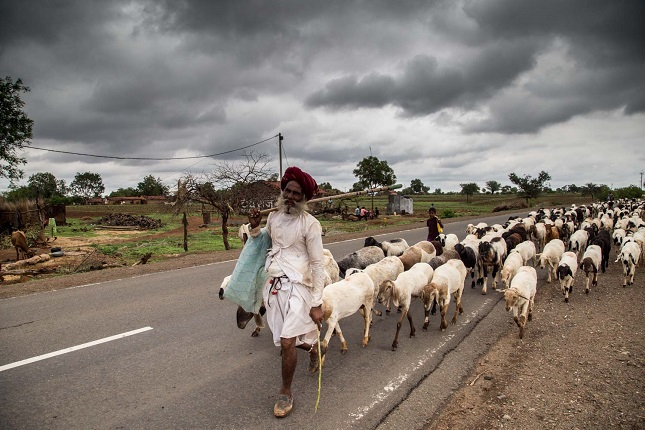
Fig. 2. A Raika shepherd from Rajasthan migrates to Malwa for the summer. As consummate pastoralists, the Raikas follow fixed patterns of migration, unless forced to improvise and change tracks under extraordinary circumstances. Photo by DINESH KHANNA.
The Raikas are ‘the pastoralists par excellence’ (Kavoori 1999:5), as well as specialist camel breeders. To date, a typical sight of western Rajasthan is the wiry figure of the Raika man wearing a thick twisted turban, holding a staff in one hand, herding his camels and sheep through the arid landscape. The even more startling sight is of a Raika dhang or caravan on the move, including entire families along with their hordes of camels and sheep. Such was the centrality of the camel in local imagination that there is an entire genre of Rajasthani folksongs dedicated to the camel, kariyo (Neuman et al. 2016:114), as well as bardic literature in praise of camels, besides lions, horses and buffaloes, known as birdalo (Thompson 1987:312).[3]

Fig. 3. A Raika follows his toolo (herd) of camels on the dusty by-lanes of western Rajasthan. A Raika on the move drives and grazes his camels and sheep during the day, camping for the night at fields along the way in exchange for letting his animals manure the fields. Photo by DHEERAJ PAUL.
Both myth and reality relegate the Raikas to the margins of local history and society. Called Shiva’s bhuts (ghosts), after he stumbled on their progenitor, Chaamad, sleeping by a funeral pyre, they are considered vagabonds who roam the wilderness looking for grazing. They are also called Rabari, those that have ‘strayed from course’ (raah bari). Their fringe position is summed up in a popular saying in Marwar: ‘Raah bahare Raika, gaon bahare ghar’, just as the Raika is outside of the mainstream, his house is outside the village.
The Raikas themselves consider their traditional occupation of camel-rearing a divine calling. They believe that they were created by Shiva to look after camels after the animal was created by Parvati. Their understanding of their place within the larger history of Rajasthan is seen in the local oral epic ‘Pabuji’ (Kothiyal 2016:127–28, 238–46). Pabuji is a folk deity, with a following mainly among the Raikas. His following among the Rajputs is based more on caste affinity as he was a Rathore Rajput. To that extent, Pabuji is primarily a subaltern deity, an apotheosised bhumia. In one of Rajasthan’s best-known epics, a colourful cast of tribal Bhil archers, Raika messengers and a Charan woman rally around the eponymous hero, as he takes on a cow-killing ruler of Patan, the demon-king of Lanka and Rajput adversaries for the sakes of his sister, niece, Bhil allies and Charan ward (Smith 1991:9–12). He not only protects cattle but also introduces camels in Marwar. In a spectacular feat of livestock rustling, Pabuji travels to Lanka, vanquishes no less an adversary than Ravana, and steals his camels. Importantly, a Raika, Harmal, does the recce and lays the groundwork for Papuji’s success in Lanka. He is in turn rewarded by Pabuji with half the contingent of camels. ‘Pabuji’ is an incredible tale full of such colourful details as Pabuji’s mother, originally a nymph, turning into a tigress and suckling her baby, the princess Phulvanti pining in a desert fortress for the footloose Pabuji, the burly Dhemo tucking his tired horse under his arm and running to catch up with the rest of Pabuji’s party, and Dhemo, also a practical joker, hiding the Charan Deval’s favourite one-eyed bull-calf in his opium box.
The same inter-caste alliances that are reflected in the epic have led to the deification of Pabuji and kept the epic alive. Composed by Charan bards, it is sung-recited by Nayak or desert Bhil bhopas (priests) for largely Raika patrons/followers.[4] The singing-recitation of the epic was once believed to have such miraculous powers that sick camels were said to have been cured by it. The epic is sung by bhopas either at shrines dedicated to Pabuji, depicted on stone steles as riding his mare, Kesar Kalami, or in association with a phad. A long cloth painted by a caste of artists, the Joshi-Chhipas, with episodes from the epic, the phad is packed with lively depictions of the extensive cast of characters—dominated by hefty depictions of a turbaned, mustachioed Pabuji, often astride his finely caparisoned horse—in a sequence that only the bhopas can interpret. It is treated as a sacred object until the paintings are well and truly faded. The bhopa and his assistant/s, often his wife, the bhopi, put on a night-long show that includes singing, playing the fiddle-like ravanhatha and dancing to narrate different episodes from the phad. The poignant notes of the ravanhatha played by the bhopa, the measured jingling of the ghungroos (bells) on the bow and on his ankles, and his full-throttle voice fill the air in an evocative performance. The singing-recitation of the entire epic typically takes seven nights. The unfurled phad performs the role of a mobile temple that the peripatetic bhopas may set up anywhere on their travels, following the trail of their nomadic herdsmen patrons. Pabuji is also invoked by the Raikas in the tale's simplest form in a group-singing practice by called jhurava. The nomadic herdsmen probably started singing the epic about their patron deity as a way of keeping their spirits up on their long and arduous journeys across the Thar and beyond.
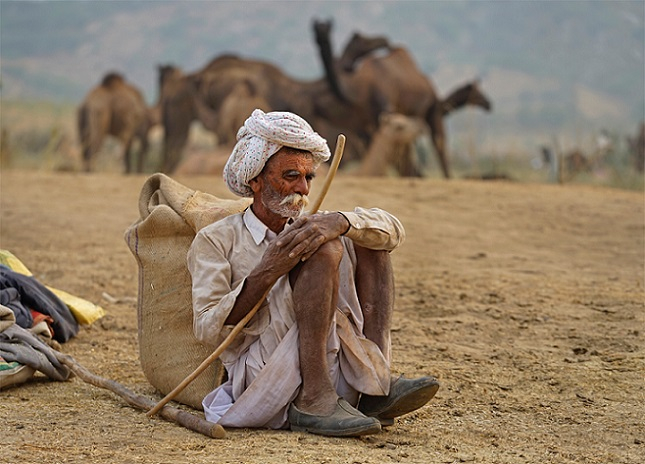
Fig. 4. A Raika lost in his thoughts at the Pushkar cattle fair. Camel-rearing Raikas congregate at the fair to sell their camels. Photo by DHEERAJ PAUL.
***
The Thar made the most of its central location on the western frontier. Trade directed towards Sindh, connecting India to Central Asia by land routes and to West Asia by sea, passed through it. Imagine caravans of camels, donkeys and Kankrej oxen trudging through the desert, transporting all kinds of goods, from textiles, salt and opium, to horses. They make their way through undulating sand dunes, in the red and yellow shades of the desert soils, past rocky little hills. They pause at wells by the shade of straggly trees. By night, the same landscape becomes moon- and star-lit silver, and the same hills appear dark looming shapes. Suddenly the caravans are swarmed by gangs of bandits armed with swords and matchlocks. They are confronted by escorts of caravan protectors. Under normal circumstances, one would imagine that these guards would be the first to get attacked. Except that they are no ordinary escorts. They are the Charans.
Far from assailing the Charans, who threaten to kill themselves in a terrible practice known as taga and, thus, lay a curse on the raiders, the bandits back off leaving the caravans untouched (Thompson 1987:299; Kothari 1994:207–08). What was so special about the Charans that hardened caravan raiders were terrified of having Charan blood on their hands? It is because this unique community of Rajasthan and Gujarat had made a reputation for themselves as deviputras or ‘sons of the goddesses’ (Thompson 1987:298–99). In this self-projection project, they were aided by the ruling elite, mainly the Rajputs, who adopted the extensive pantheon of Charan goddesses as their kuladevis or patron deities, and the Charans as their bards. This link between the Rajputs and the Charans is reflected in epics such as ‘Pabuji’, where Pabuji’s Charan ward is supposed to be an incarnation of the goddess Durga. The Bhats performed the role of the genealogists of the Rajputs, while the Charans composed panegyrics and eulogised their patrons. It was a defining feature of social life in the Thar that all communities, not just the ruling castes, had genealogists and musicians attached to them, as is discussed in the next section. This in itself is reflective of a nomadic culture, where histories had to be preserved orally.
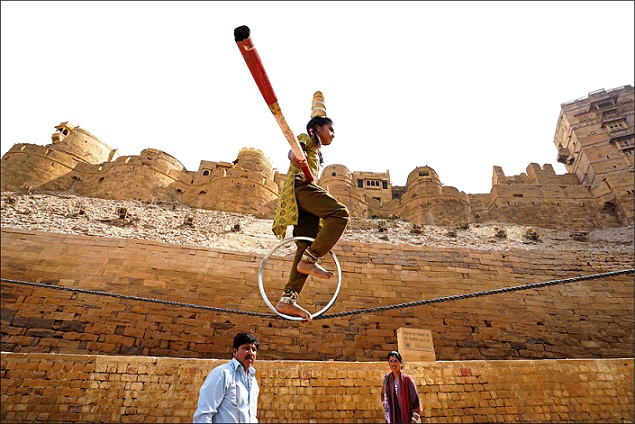
Fig. 5. A girl acrobat from the Nat community performs a feat of gymnastics against the imposing backdrop of the yellow sandstone fort of Jaisalmer. Acrobats from the community travel to different cities and villages in Rajasthan and beyond offering entertainment. Photo by DHEERAJ PAUL.
Charan bards brought the same force to their words as they did to their personality when they committed taga. The Rajput would ride into battle accompanied by a Charan, his poetry ringing in his ears (Thompson 1987:299). Although there is evidence of the relationship between the two communities souring under colonial intervention (Kothiyal 2016:211–13), previously they had shared a symbiotic alliance. The Charans acted as arbitrators and guarantors in dealings and agreements between Rajputs, once again resorting to taga if one party did not keep his end of the bargain. Such glorification of death worked in a society dominated by a Rajput community that set great store by dying in the battlefield for Rajput men and by self-immolation for their women. The Charans were after all the repositories of Rajput narratives of valour and honour. In return for their services, the Charans received generous grants of land and gifts of livestock, as well as all kinds of privileges, from dining and consuming opium with their patrons to being spared from paying various taxes.
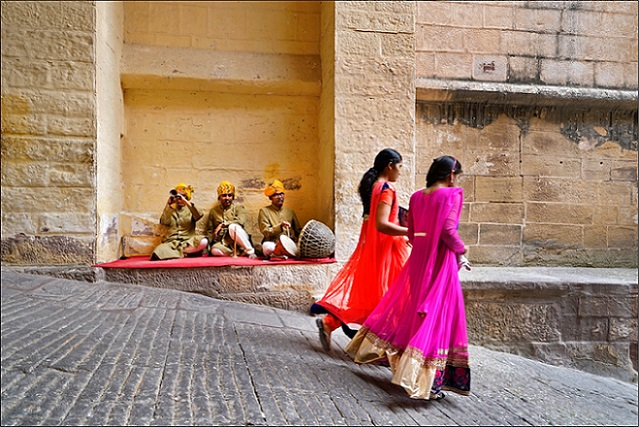
Fig. 6. Musicians from the Nagarchi community are seen here performing on the nagara and shenai at the main door of the Mehrangarh Fort in Jodhpur. The troupe is led by Umar Nagarchi from the city. Photo by DHEERAJ PAUL.
Hence, the Charans were entrenched in two of the most powerful networks of the Thar: trade and the feudal order. This is notwithstanding their humble beginnings as probably pastoralists. According to their myth of origin, they had an origin comparable to the Raika’s, since they were created by Shiva to look after cattle. This is reiterated in the etymology of their name—‘grazier’. But in any case, in the Thar, communities had to combine various sources of livelihood to survive. Droughts and famines were so commonplace that there is an entire corpus of bardic outpourings of grief (Kavoori 1999:65–67; Thompson 1987:312). There are plenty of instances of famines leading to entire villages uprooting and resettling in different parts within the western frontier and beyond. The Charans happened to be a typically versatile community, starting out as agro-pastoralists but going on to take on highly specialised roles. It is no wonder that, in the process of serving as caravan escorts, they gained such deep knowledge of the desert that many grew in trade to the extent of becoming traders in their own right and commanding caravans of their own. Who on earth would dare attack a Charan caravan?
***
Perhaps no other community better embodies the shared history, fostered by a culture of mobility, of the western frontier than its folk musicians. David Neuman, Shubha Chaudhuri and Komal Kothari attribute the versatility of the folk music of Rajasthan to its nomadic traditions, ‘an exigency of its severe ecological conditions—which has introduced its musical specialists to listeners of varying cultural sensibilities . . .’ (Neuman et al. 2006:4). The dominant musician communities of the Thar are the renowned Manganiars and Langas. Both communities are found on either side of the India-Pakistan border that divides Rajasthan from Sindh and, to an extent, in Kutch. Both practise Islam, although they are socially organised into sub-castes and clans in a manner that attests to a Hindu past and Hindu patrons (including one-time Hindu patrons in the case of the Langas). A fixed set of traditional patrons was fundamental to their way of life as musicians, in a system known as jajmani. Although the general impression is that the Manganiars were the minstrels of the Rajputs, they in fact extended their services to all those families from different communities, rich and poor, upper or lower caste, that provided services to their Rajput patrons. The Langas were exclusively attached to Muslim Sindhi Sipahi patrons, also serving as their genealogists. As patron families grew and spread, so too did the services offered by the associated musician families, often increasing the geographical remit of their services. In earlier times, for example, if a Rajput patron had two sons and the younger one decided to move and set up shop in some other part of Rajasthan, different male members of the associated Manganiar family would divide the two brothers between them and one of these Manganiars would have to be prepared to travel to the younger one’s new home. In modern times, in another example, even if a family of Langas moved to a city, the musicians would still have to travel to the remote villages of their traditional patrons to fulfill their obligations. Before Partition, these musicians would have crisscrossed an even greater distance covering Rajasthan and Sindh. Indeed, until the Indian-Pakistan War of 1971, the border between the two countries remained fluid for these musicians as I was told in the course of fieldwork in western Rajasthan. The border guards, who may have looked the other way previously, were less inclined to indulge a band of sarangi-wielding Langas making their way across the desert. Even today the tense boundary between India and Pakistan is often circumvented in service of these traditional ties. Kothari cites an instance when a fall-out between a Langa family from India and another from Pakistan saw the counterpart patron families of Sindhi Sipahis on either side of the border getting involved and helping to breach the rift (Neuman et al. 2006:224).[5]
The musicians are usually seen wearing a white kameez and baggy salwars, the dash of colour provided by bright tie-dye turbans. On special occasions when they perform, they can wear silver buttons and chains. In winter, they put on long black coats over their kameez and wrap up in thick shawls. They were expected to provide their services on occasions such as births, marriages, deaths, festivals, and musical gatherings known as kacheris. They vary their extensive repertoire of music to suit different occasions.
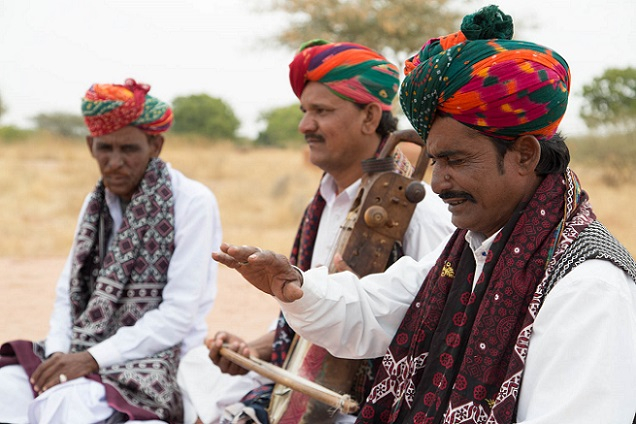
Fig. 7. From right to left, the vocalist Sardar Khan Langa, Kasam Khan Langa on the sindhi sarangi and the vocalist Askar Khan Langa are seen here wearing the colourful turbans and scarves favoured by the professional folk musicians. Photo by DINESH KHANNA.
Besides the specific songs associated with life-cycle ceremonies, there are songs about the different seasons—barsalo (rains), unalo (summer), basant (spring), siyalo (winter); playful songs about a female community of winesellers, Kallali; songs about horses (ghoro) and camels; and of course about the great romances of the region (Neuman et al. 2006:140–49). These include Dhola-Maru, Moomal-Mahendra/Rano, Umar-Marvi and Sassi-Punnu. The Sufi strain in at least some of them, adapted from the risalo of Shah Abdul Latif Bhitai, is unmistakable (Neuman et al. 2006:110–11). The incorporation of Sindhi Sufi poetry in the folk music of Rajasthan is testimony to the cultural interactions within the western frontier (Kothari 1994:233). Tanuja Kothiyal makes a touching point: ‘Most of these musician communities travel over long spans to attend to their patrons’ needs. Not only do they accumulate varying traditions as part of their repertoire, they themselves are part of these plaintive songs of separation, as they too are mobile’ (Kothiyal 2016:261; emphasis mine). It is worth noting that, of late, the shared repertoire of these musicians is closing ranks around post-colonial geo-political identities. The musicians in India have become more ‘Hinduised’, struggling to remember Sufi kalaams.
But the original spread of these music traditions is also seen in the different instruments used by the different communities. Only the Manganiars, for example, play a bowed lute called kamaicha, which is found in western Rajasthan and parts of Sindh, although Kothari attributes its origin to Gujarat (Neuman et al. 2006:163). Of the two classes of Langas, the Sarangiyas and the Surnaiyas, the latter are the only musicians from Rajasthan to play the string instrument sarinda or surinda, although it is found from Baluchistan in Pakistan to north and east India (Neuman et al. 2006:125). The Sarangiya Langas sing to the music of local forms of the sarangi, which are also used by the Manganiars. The names of two kinds of sarangis, the sindhi sarangi and the gujratan sarangi, suggest a provenance in Sindh and Gujarat (Kothari 1972:3). The Surnaiya Langas are strictly instrumentalists, their primary instruments being aerophonic—mainly the surnai and the murla, the sarinda providing the accompaniment (Kothari 1972:25). Another instrument unique to the Surnaiya Langas in Rajasthan, its use extremely rare even in this context, is a long flute known as narh, which is otherwise found in Baluchistan and Sindh. In Sindh, this instrument seems to have provided an important note in love songs (Neuman et al. 2006:137).
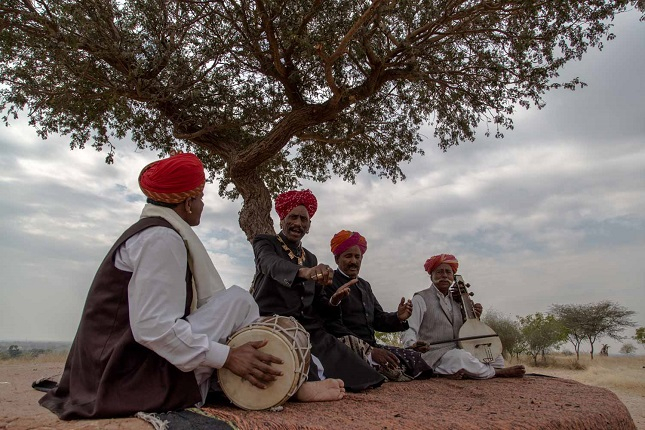
Fig. 8. From left to right, Pappa Khan Manganiar on the dholak, the vocalist Gazi Khan, the vocalist Multan Khan Manganiar and Hakam Khan Manganiar on the kamaicha, are seen here performing under the cloudy winter sky of Jodhpur at Arna Jharna: The Desert Museum in the Jodhpur area. Photo by DINESH KHANNA.
Traditionally, the Langa and the Manganiars lived in dedicated settlements within villages, villages in the region often consisting of scattered settlements. Indeed, the Sarangiya and Surnaiya Langas usually lived in different villages. But a village was a little more than ‘a base camp . . . for a much wider, indeed regional network of places that circumscribes where [the musician] works and encompasses those that are his people’ (Neuman et al. 2006:10). They also practiced limited agro-pastoralism, many of their livestock being gifts from patrons. The income from this was supplemented by the income from their patrons derived in cash or kind such as gifts of clothes, jewellery, a horse, a camel or a calf, grain and dairy produce. The musicians were paid on occasions when they performed at life-cycle ceremonies or in kacheris, or through annual or occasional tributes due to them.
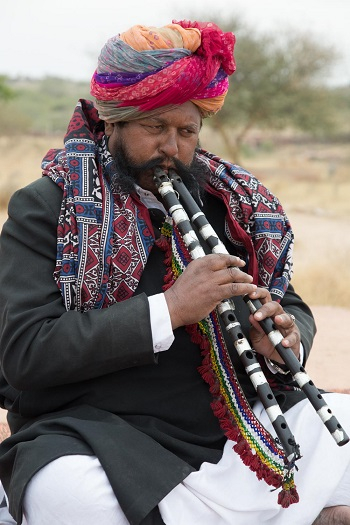
Fig. 9. Mehruddin Langa plays the algoza, a double flute. Photo by DINESH KHANNA.
***
Nomadism was the way of life in the Thar. So much so that the earliest settled states of the region were established by wandering soldiers (Gommans 2002:53–54). Their chieftains, recast as Rajput rulers, initially accommodated nomadic lifestyles alongside their increasingly fixed polities. Less so under Mughal rule with its emphasis on a court-centric culture based on a settled agrarian society—notwithstanding their own tent-dwelling nomadic Central Asian origins.[6] Their Rajput feudatories emulated Mughal culture, also forgetting their own nomadic past (Kolf 1990; Gommans 2002:40). But, importantly, the Mughal-Rajput order did not necessarily look down on nomadism as much as it emphasised a settled society. Indeed, Jos Gommans has even argued that late medieval ‘state formation [was based] on the dynamic interaction between sedentary and nomadic people’ (Gommans 2002:3–4). Neeladri Bhattacharya points out with reference to another semi-arid region of western India, south-east Punjab, ‘the pioneer colonizers—the Sikh Jats from the north, the Bagri Jats from the south, and the Muslim Jats and Rajputs from the neighbourhood of Sutlej—had to operate against the ecological constraints of the region. They settled villages, cleared forests and ploughed the soil, but accepted pastoralism as an integral part of their economic activity. Agriculture did not replace pastoralism; they coexisted’ (Bhattacharya 1995:59). Contempt for nomadic lifestyles and, consequently, an official policy to put an end to this way of life was reserved for the British colonisers of India.
see the section ‘The Intellectual Journey’ in the overview article, 'Reimagining Rajasthan', of the module ‘An Institutional History of Rupayan Sansthan, Jodhpur’
The colonial project in India, in short, was driven by the need to ‘make sense’ of a subcontinent that could not have been more alien from Britain. The colonists went about this by regulating India, controlling nature and natural resources, and classifying and characterising the Indian ‘races’ in a manner that suited prevailing European ideals (for examples from the western Himalayas to Punjab, see, Bhattacharya 1995; Moran 2007; Kennedy 1996:39–87; Chandra 2014). In the case of the Thar, it meant that the colonial state, with the help of their Rajput protectorates, attempted to curb pastoralism and nomadism, equated with vagrancy and laziness in the colonial imagination, as opposed to agriculture and landownership, associated with industriousness and productiveness. It meant favouring certain communities, like the Rajputs, imagined as the Indian equivalent of gallant medieval English-Scottish knights, while damning others as inherently criminal under the monstrous Criminal Tribes Act, 1871. It should be noted that this was as much a problem of orientalist writing as official colonial policy; the two conflated in figures such as the British administrator-historian James Tod (Tod 1920). ‘They romanticized the Rajput and essentialized chivalry, valor and pride as Rajput values, which were as much constructs of historiography as criminalizing of certain communities were’ (Kothiyal 2016: 120) (see the section, ‘The Intellectual Journey’, in the overview article, ‘Reimagining Rajasthan' of the module, An Institutional History of Rupayan Sansthan, Rajasthan’).
Itinerant communities such as the Banjaras, Bawariyas, Bhils and Minas were officially notified and circumscribed. If not notified, pastoral, bardic and musician communities were condemned and harassed, bards and musicians deemed ‘extortionist’ for demanding what they imagined were their customary dues from their patrons (Kothiyal 2016:209–16). Kothiyal argues that the colonial state was not just motivated by a general wariness of mobility, but in fact set out to ‘minimize the kind of control that mobile communities exercised on circulatory networks in the Thar’ (Kothiyal 2016:214). Since the 19th century, the wide open spaces of the desert frontier have been shrinking, so to speak, with the addition of state regulations and political boundaries.
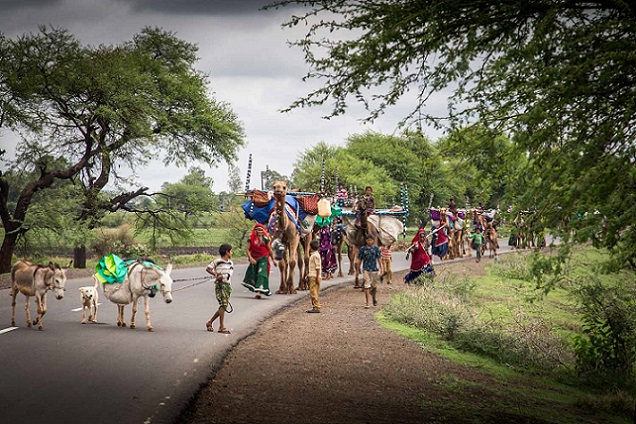
Fig. 10. Raika camel caravans on their way to Malwa from Rajasthan. Note the prominent role of the Raika women in driving these caravans, the men having gone ahead to scout for pasture, water and camping area. Uttra Kothari, the daughter of Komal Kothari and an expert on the Raikas, explains that in the past five years, the troubles of the Raikas have increased as getting past district and state boundaries becomes more and more difficult. Consequently, while the men manage all the paperwork and permits, the women often the take the lead in managing the animals. Photo by DINESH KHANNA.
In a manner of speaking, India’s nomadic past stands at the final crossroad in post-Independence India. Mainstream India sees glimpses when one reads Rudyard Kipling’s Kim in school, passes a grizzled shepherd driving his sheep on a highway in Rajasthan or a famous photographer treks to desert outposts to bring us dramatic photos of Banjara women in bright red dresses turning their backs on a sandstorm.[7] The Indian nation state’s attempts to protect vulnerable and marginlised communities through giving them reserved status, its efforts to accommodate them alongside or integrate them within its development discourse is yet to run its course. But what these frontier people do represent is an India grappling to adjust the demands of modernity with its diverse, complex history.
References
Bhattacharya, Neeladri. 1995. ‘Pastoralists in a Colonial World.’ In Nature, Culture, Imperialism: Essays on the Environmental History of South Asia, eds David Arnold and Ramachandra Guha. Delhi: Oxford University Press.
Chandra, Yashaswini. 2014. ‘The Colonial Backdrop to the Western Himalaya.’ In The Presidential Retreats of India, ed. Gillian Wright. Rashtrapati Bhavan Series. New Delhi: Publications Division, Government of India.
Gommans, Jos. 2002. Mughal Warfare: Indian Frontiers and High Roads to Empire, 1500–1700. London and New York: Routledge.
Kennedy, Dave. 1996. Magic Mountains: Hill Stations and the British Raj. Berkeley: University of California Press.
Kohler-Rollefson, Ilse. 2014. Camel Karma: Twenty Years among India’s Camel Nomads. Chennai: Tranquebar Press.
Kolf, Dirk H.A. 1990. Naukar, Rajput and Sepoy: The Ethnohistory of the Military Labour Market in Hindustan, 1450–1850. Cambridge: Cambridge Unversity Press.
Kothari, Komal. 1972. Monograph on Langas: A Folk Musician Caste of Rajasthan. Jodhpur: Rupayan Sansthan.
———. 1994. ‘Musicians of the People: The Manganiyars of Rajasthan.’ In The Idea of Rajasthan, vol. 1: 'Constructions', eds Karine Schomer, Joan L. Erdman, Deryck O. Lodrick and Llyod I. Rudolph. Delhi: Manohar and American Institute of Indian Studies.
Kavoori, Purnendu. 1999. Pastoralism in Expansion: The Transhuming Herders of Western Rajasthan. Delhi: Oxford University Press.
Kothiyal, Tanuja. 2016. Nomadic Narratives: A History of Mobility and Identity in the Great Indian Desert. Delhi: Cambridge University Press.
Moran, Arik. 2007. ‘From Mountain Trade to Jungle Politics: The Transformation of Kingship in Bushahr, 1815–1914.’ In Indian Economic and Social History Review 40.2:147–77.
Neuman, Daniel, Shubha Chaudhuri with Komal Kothari. 2006. Bards, Ballads and Boundaries: An Ethnographic Atlas of Music Traditions in Western Rajasthan. Calcutta, London and New York: Seagull Books.
Shackle, Christopher. 2007. ‘The Shifting Sands of Love’. In Love in South Asia: A Cultural History, ed. Francesca Orsini. Delhi: Cambridge University Press.
Smith, John D. 1991. The Epic of Pabuji, A Study, Transcription and Translation. Cambridge: Cambridge University Press.
Seshan, Radhika. 2016. 'Locating Sindh in the Trading World of Asia', interview for Sahapedia. Online at https://www.sahapedia.org/locating-sindh-the-trading-world-of-asia (viewed on July 17, 2017).
Thompson, Gordon. 1987. ‘Music and Values in Gujarati speaking Western India’. PhD thesis, University of California, Los Angeles.
Tod, James. 1920. Annals and Antiquities of Rajasthan: Or the Central and Western Rajput States of India, three volumes, ed. William Crooke. London: Oxford University Press.
Vaudeville, Charlotte. 1996. 'Leaves from the Desert: The Dhola Maru ra Duha: An Ancient Ballad of Rajasthan’. In Myths, Saints and Legends in Medieval India', ed. Vasudha Dalmia. New Delhi: Oxford University Press.
Notes
[1] Dirk H.A. Kolf has demonstrated the mobility of casual soldiering as a key feature of the military labour market of north India going back to at least the 15th century (Kolf 1990). Note, however, that Kolf emphasises the role of peasant-warrior communities from eastern north India, as corresponding to eastern UP, and Bihar, and not Rajasthan. The reasons for Rajasthan’s limited participation are not clarified. It is also worth noting that from the Mughal period onwards, it was the Rajputs of Rajasthan who managed to gain the reputation of an exclusive group of consummate Rajputs, distinguished from ‘spurious’ ones.
[2] This account is primarily based on the recension recorded by Charlotte Vaudeville (Vaudeville 1996).
[3] The humble sheep is, in contrast, not in the least valorised even though Rajasthan accounts for nearly 50% of India’s wool production and is a major supplier of mutton (Kavoori 1999:7). Camels are never reared for meat in the Thar.
[4] A forthcoming module from this series is on Rajasthani epics by John D. Smith. It includes an article, ‘The Epic of Pabuji’.
[5] Speaking of fluid boundaries, Ilse Kohler-Rollefson recounts a delightful conversation with a couple of Sindhi Sipahis from Jaisalmer, who explain that when their camels stray across the international border at Jaisalmer, they inform the Border Security Forces (BSF), themselves often camel-borne on their patrols. The BSF personnel in turn inform their counterparts across the border, who are sure to send the camels back! (Kohler-Rolleson 2014:81–82).
[6] Although the location of the court kept shifting.
